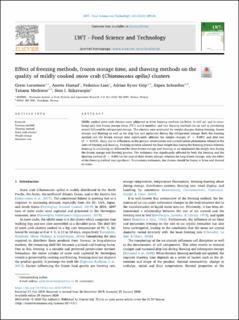| dc.contributor.author | Lorentzen, Grete Elisabeth | |
| dc.contributor.author | Hustad, Anette | |
| dc.contributor.author | Lian, Federico | |
| dc.contributor.author | Grip, Adrian Eyser | |
| dc.contributor.author | Schrødter, Espen | |
| dc.contributor.author | Medeiros, Tatiana | |
| dc.contributor.author | Siikavuopio, Sten Ivar | |
| dc.date.accessioned | 2020-04-21T09:11:05Z | |
| dc.date.available | 2020-04-21T09:11:05Z | |
| dc.date.created | 2020-04-20T14:52:03Z | |
| dc.date.issued | 2020 | |
| dc.identifier.citation | Lebensmittel-Wissenschaft + Technologie. 2020, 123 1-8. | |
| dc.identifier.issn | 0023-6438 | |
| dc.identifier.uri | https://hdl.handle.net/11250/2651811 | |
| dc.description.abstract | Mildly cooked snow crab clusters were subjected to three freezing methods (in brine, in still air, and in circulating air), two frozen storage times (72 h and 6 months), and two thawing methods (in air and in circulating water) followed by refrigerated storage. The clusters were evaluated for weight changes during freezing, frozen storage and thawing as well as for drip loss and melanosis during the refrigerated storage. Both the freezing method and the frozen storage time significantly affected the weight changes (P < 0.001) and drip loss (P < 0.015), likely due to differences in the protein denaturation and crystallization phenomena related to the rates of freezing and thawing. Freezing in brine allowed the least weight loss during the freezing process whereas freezing in circulating air followed by short frozen storage and thawing in air minimized the weight loss during the frozen storage and thawing process. The melanosis was significantly affected by both the freezing and the thawing method (P < 0.001) in the case of short frozen storage, whereas for long frozen storage, only the effect of the freezing method was significant. To minimize melanosis, the clusters should be frozen in brine and thawed in water. | |
| dc.language.iso | eng | |
| dc.title | Effect of freezing methods, frozen storage time, and thawing methods on the quality of mildly cooked snow crab (Chionoecetes opilio) clusters | |
| dc.type | Peer reviewed | |
| dc.type | Journal article | |
| dc.description.version | publishedVersion | |
| dc.source.pagenumber | 1-8 | |
| dc.source.volume | 123 | |
| dc.source.journal | Lebensmittel-Wissenschaft + Technologie | |
| dc.identifier.doi | 10.1016/j.lwt.2020.109103 | |
| dc.identifier.cristin | 1807166 | |
| dc.relation.project | Norges forskningsråd: 267763 | |
| dc.relation.project | Nofima AS: 11928 | |
| cristin.ispublished | true | |
| cristin.fulltext | original | |
| cristin.qualitycode | 1 | |
